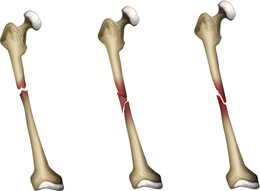Most cases of broken femur bone are serious, and are caused due to high energy injuries like car accidents, sports injuries, or falls. Although there are nonsurgical treatment options for a femur fracture, surgery is recommended for almost all adult patients.

The thighbone or femur is the largest of all bones, which connects the hip joint (or coxa) and the knee joint (genu). It has the greatest strength as compared to other bones in the human body. Even though it is the strongest bone, it can break. For people with healthy bones, the common causes of fracture in the thighbone are falling from a great height, a vehicle accident, or a sports injury. People diagnosed with weak bones, osteoporosis, or other bone abnormalities are at a higher risk than others.
Signs and Symptoms
Depending upon the actual position of injury, a broken thighbone is categorized under three major types. They are proximal fracture or hip fracture (upper portion), femoral shaft fracture (shaft), and supracondylar femur fracture (just above the knee joint). Another classification is based on the severity of the fracture. While some patients have a simple fracture (with two broken pieces), a complex fracture involves breaking the thighbone in two ore more fragments.
The most notable symptoms are severe hip bone pain, deformity, and limited leg movement (injured side). The fracture area exhibits bruising, tenderness, swelling, and inflammation. Other medical conditions that may accompany a femur fracture are open wound, bleeding, shortening of the thigh, reduced blood circulation, and impaired sensation. Immediate attention for this bone fracture is imperative to avoid further medical complications. The doctor will examine the physical symptoms and conduct X-ray imaging to study the fractured thighbone.
Treatment and Surgery
As far as treatment is concerned, it depends on the severity of the injury. But, the two most common forms of treatment are surgery and nonsurgical procedures. Say for instance, the less common supracondylar femur fracture is treated with either of the two methods, whereas, hip and femoral shaft fractures require surgery. Nonsurgical treatment involves casting, screwing, or using external fixators, amongst others. In case of children, the orthopedist may suggest a cast for healing the fractured thighbone.
For patients with serious underlying medical conditions, therapeutic intervention other than surgery is considered first. When this does not show prompt results, surgery is performed as the last resort. In the surgery, an Intramedullary (IM) rod made up of metal is introduced inside the thighbone (at the center). This holds the broken bones in place, and partially supports the injured thigh bone for bearing weight. And for fixing the metal rod, screws are fastened to both sides of the fractured area.
The surgery requires 3 hours or more for completion. After that, the patient is expected to stay in the hospital for 2 - 3 days, or more. During this stay, dressings are changed and the doctor will inspect for any signs of infection. For movement purposes, the patient will be asked to use crutches for support, at least for 2 - 3 months. High intensity pain is experienced in the first few weeks after surgery. Painkillers are prescribed to get relief from pain.
Post Surgery Recovery
Following the operation, every patient should go for follow-up visits, in which the doctor will take X-rays to check for improvement. Also, physical therapy is performed to increase mobility and shorten the healing period. In a nutshell, surgery is the most reliable treatment for severe cases of femur fracture, especially in adults. Of course, complications exist, similar to any type of surgical procedure. Commonly reported postoperative complications are infections and rejection of the metal device by the body.
Needless to say, the recovery time depends on the severity of the injury and the surgical procedure. On an average, complete recovery takes about 3 - 9 months. The intramedullary rod is safe for retaining forever, throughout the person's life. However, if hip pain is experienced at the fracture site, this metal device may be removed later by performing another surgical procedure.
Disclaimer:
This Buzzle article is for informative purposes only, and should not be replaced for the advice of a medical professional.


 The thighbone or femur is the largest of all bones, which connects the hip joint (or coxa) and the knee joint (genu). It has the greatest strength as compared to other bones in the human body. Even though it is the strongest bone, it can break. For people with healthy bones, the common causes of fracture in the thighbone are falling from a great height, a vehicle accident, or a sports injury. People diagnosed with weak bones, osteoporosis, or other bone abnormalities are at a higher risk than others.
The thighbone or femur is the largest of all bones, which connects the hip joint (or coxa) and the knee joint (genu). It has the greatest strength as compared to other bones in the human body. Even though it is the strongest bone, it can break. For people with healthy bones, the common causes of fracture in the thighbone are falling from a great height, a vehicle accident, or a sports injury. People diagnosed with weak bones, osteoporosis, or other bone abnormalities are at a higher risk than others.